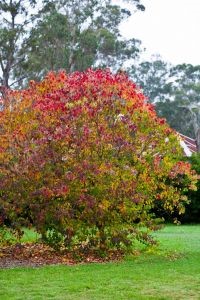
by Sheila Dunning | Nov 9, 2018
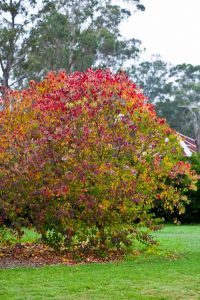 As the trees begin to turn various shades of red, many people begin to inquire about the Popcorn trees. While their autumn coloration is one of the reasons they were introduced to the Florida environment, it took years for us to realize what a menace Popcorn trees have become. Triadica sebifera, the Chinese tallowtree or Popcorn tree, was introduced to Charleston, South Carolina in the late 1700s for oil production and use in making candles, earning it another common name, the Candleberry tree. Since then, it has spread to every coastal state from North Carolina to Texas, and inland to Arkansas. In Florida it occurs as far south as Tampa. It is most likely to spread to wildlands adjacent to or downstream from areas landscaped with Triadica sebifera, displacing other native plant species in those habitats. Therefore, Chinese tallowtree was listed as a noxious weed by the Florida Department of Agriculture and Consumer Services Noxious Weed List (5b-57.007 FAC) in 1998, which means that possession with the intent to sell, transport, or plant is illegal in the state of Florida. The common name of Florida Aspen is sometimes used to market Popcorn tree in mail-order ads. Remember it’s still the same plant.
As the trees begin to turn various shades of red, many people begin to inquire about the Popcorn trees. While their autumn coloration is one of the reasons they were introduced to the Florida environment, it took years for us to realize what a menace Popcorn trees have become. Triadica sebifera, the Chinese tallowtree or Popcorn tree, was introduced to Charleston, South Carolina in the late 1700s for oil production and use in making candles, earning it another common name, the Candleberry tree. Since then, it has spread to every coastal state from North Carolina to Texas, and inland to Arkansas. In Florida it occurs as far south as Tampa. It is most likely to spread to wildlands adjacent to or downstream from areas landscaped with Triadica sebifera, displacing other native plant species in those habitats. Therefore, Chinese tallowtree was listed as a noxious weed by the Florida Department of Agriculture and Consumer Services Noxious Weed List (5b-57.007 FAC) in 1998, which means that possession with the intent to sell, transport, or plant is illegal in the state of Florida. The common name of Florida Aspen is sometimes used to market Popcorn tree in mail-order ads. Remember it’s still the same plant.
Although Florida is not known for the brilliant fall color enjoyed by other northern and western states, we do have a number of trees that provide some fall color for our North Florida landscapes. Red maple, Acer rubrum, provides brilliant red, orange and sometimes yellow leaves. The native Florida maple, Acer floridum, displays a combination of bright yellow and orange color during fall. And there are many Trident and Japanese maples that provide striking fall color. Another excellent native tree is Blackgum, Nyssa sylvatica. This tree is a little slow in its growth rate but can eventually grow to seventy-five feet in height. It provides the earliest show of red to deep purple fall foliage. Others include Persimmon, Diospyros virginiana, Sumac, Rhus spp. and Sweetgum, Liquidambar styraciflua. In cultivated trees that pose no threat to native ecosystems, Crape myrtle, Lagerstroemia spp. offers varying degrees of orange, red and yellow in its leaves before they fall. There are many cultivars – some that grow several feet to others that reach nearly thirty feet in height. Also, Chinese pistache, Pistacia chinensis, can deliver a brilliant orange display.
Young Trident maple with fall foliage. Photo credit: Larry Williams
There are a number of dependable oaks for fall color, too. Shumardi, Southern Red and Turkey are a few to consider. These oaks have dark green deeply lobed leaves during summer turning vivid red to orange in fall. Turkey oak holds onto its leaves all winter as they turn to brown and are pushed off by new spring growth. Our native Yellow poplar, Liriodendron tulipifera, and hickories, Carya spp., provide bright yellow fall foliage. And it’s difficult to find a more crisp yellow than fallen Ginkgo, Ginkgo biloba, leaves. These trees represent just a few choices for fall color. Including one or several of these trees in your landscape, rather than allowing the Popcorn trees to grow, will enhance the season while protecting the ecosystem from invasive plant pests.
For more information on Chinese tallowtree, removal techniques and native alternative trees go to: http://edis.ifas.ufl.edu/ag148.
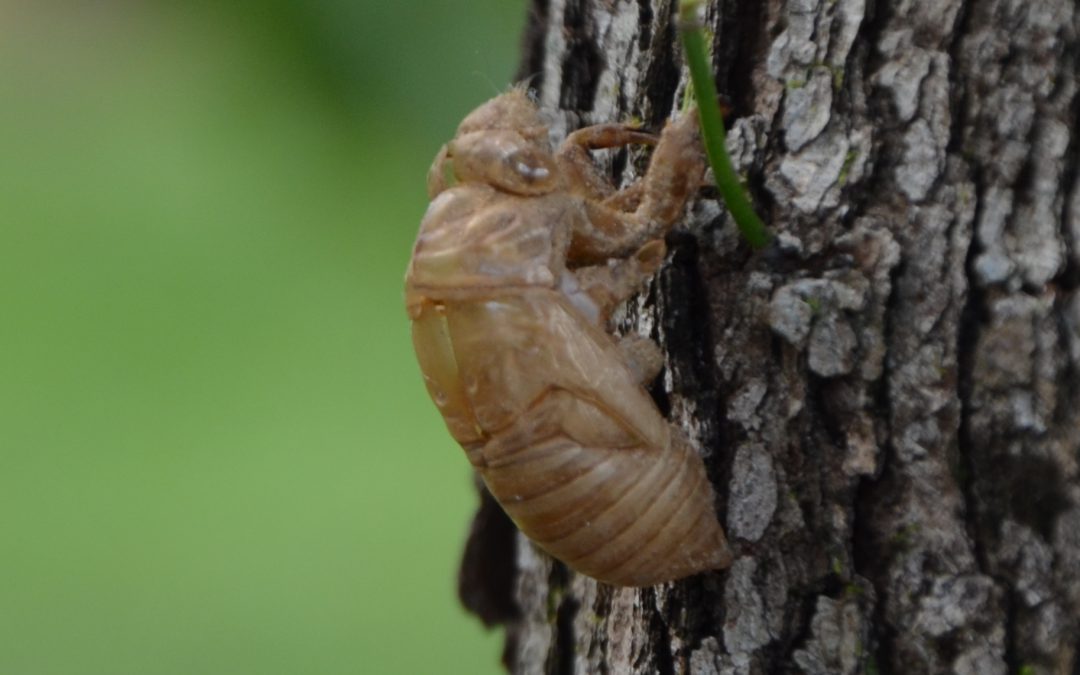
by Les Harrison | Oct 26, 2018

Only a shell of its former self, the exoskeleton shed by a cicada is all that remains of the previous night’s long pursuits.
Autumn evenings in the panhandle are usually beginning to reflect the official change of seasons with cooler air and a slight lessening of the raucous din created by insects and birds. The recent early-fall hurricanes have brought the area a wide breath of hot, humid air, delaying the long anticipated start of relief from the sultry summer environment.
Anyone hearty enough to take an early evening walk in north Florida will experience a continuation of the frenetic activity and riotous sounds typical to summer in the south. The near deafening call of cicadas (Magicicada spp.) is part of the cacophony.
Once commonly identified as locust in the region, their near-mechanical buzzing originates from the protection of foliage in trees and bushes during the day or twilight hours. During the dark hours they sing often and relocate frequently.
It is important to note cicadas are not the locust of infamy which shred the green, lush landscapes and foretells famine. While locust and cicadas are both insects, the similarities end there.
These seldom seen or captured insects known for their boisterous, sometimes undulating, chorus do leave strategically placed souvenirs for the sharp-eyed observer. This discarded residue of their early life stages is a highly valued tool for many elementary school boys with a prank in mind. The hard shell is harmless, but under the right conditions does have a certain shock value appreciated by juvenile miscreants.
Their nymph stage skeletons are often seen on the trunks of trees, shrubs stalks and even the siding of buildings. The opaque brown shells are abandoned when the cicada outgrows it and then emerges to form a new exterior.
The process is similar in other insect species with an exoskeleton having very limited potential for growth and expansion. The rigid coating provides this creature an armored surface to fend off the challenges of being small and small in a big hungry world.
In some states, cicadas are famous for their periodic appearance in colossal numbers, sometimes as many as 1.5 million per acre. These once every 13 to 17 year swarms do not occur in Florida which has an insect friendly environment.
The 19 Florida cicada species fall into three groups based on overall size measured by the length of the forewings. They produce their songs with timbals, paired drum-like structures on the sides of the abdominal segments.
A muscle attached to the timbal plate causes the timbal ribs to pop inward and project outward when relaxed. Flexed rapidly, the cicada chorus can deliver hours of uninterrupted night music.
In Florida, only males have timbals and the females are mute. Most sounds made by males are calling songs which serve to attract the silent females.
Cicada nymphs live in underground burrows where they feed on xylem sap from roots of grasses or woody plants. Because xylem sap is low in nutrients, complete nymph development takes several years to successfully mature.
All cicada species molt four times underground. When the cicada nymph is ready for its fifth and final molt it makes its way to the soil’s surface. It climbs a short distance up a tree trunk or stem, anchors itself and molts for the last time becoming an adult.
If male, the new cicada will add its contribution to the nightly festivities. If female, she will quietly wait for that special, one in a million, nocturnal crooner.
To learn more about north Florida’s noisy night insects, contact the local UF/IFAS County Extension Office. Click here for contact information.
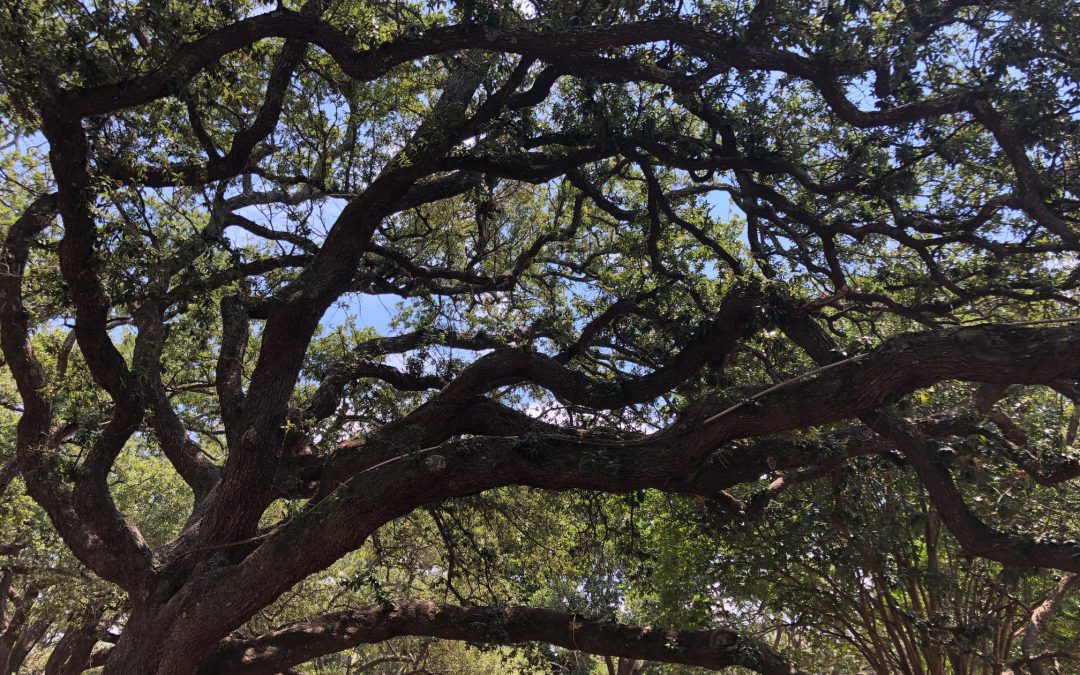
by Carrie Stevenson | Oct 26, 2018

Large trees can cause serious damage in a storm, but it is important to salvage as many as surviving trees as possible. Photo credit: Carrie Stevenson
It has been more than two weeks since devastating Hurricane Michael landed hard on the coast of Florida. Central-Panhandle counties from the Gulf to the Alabama line are in full recovery mode, struggling to return to normal after many days without power and clean water. A strong category 4 hurricane, Michael brought sustained winds of 155 mph, with gusts likely much higher—many instruments that measured wind speed failed and blew away with the onslaught of the storm.
Unfortunately, with winds this strong, trees of every shape and description blew down, bringing with them serious damage to homes, vehicles, and power lines. In the immediate aftermath of a storm, it is important to perform “tree triage” using the same method as emergency room personnel as they decide which patients to treat first, based on urgency.
Hazard trees causing or leading to unsafe conditions should be given priority. These would be limbs and trunks on top of houses, power lines, blocking roads, or leaning in precarious situations that could blow down on people or property. Once roads are cleared and dangerous trees and limbs are removed, homeowners can move their attention to downed trees that are lying out of harm’s way or leaning away from property.
It is important to remember that many injuries from hurricanes happen after a storm—often when physically and emotionally exhausted storm victims are using heavy machinery at elevated heights. Always be willing to ask for help, whether from volunteers, neighbors, or landscape professionals. Use proper safety precautions when utilizing chainsaws, ladders, tractors, and other machinery.
On a more positive note, many trees can be salvaged after a storm. In particular, younger, newly planted trees can often be righted or pruned and still grow to maturity. Don’t fall into the trap of clearing every tree from your property—healthy or not—out of fear. Trees are extraordinarily valuable, and particularly with all of the tree loss it is more important than ever to save as many trees as you can. These trees will provide much-needed shade, oxygen, air and stormwater filtration, and wildlife habitat. Learn the names of your trees that survived or had less damage, and plant more of those after recovery. Many long-lived species like magnolia, live oak, and cypress can weather storms better than other species.
It is important to continue monitoring any surviving trees for damage. Many trees, particularly pines, can be susceptible to disease, insect damage, and fungus after a storm and it may be several months before the damage is fully evident. After Hurricane Ivan, many pine forests and individual trees that survived the storm were lost to pine bark beetles within the following year.
For detailed information on tree assessment and making wise decisions, the IFAS Trees and Hurricanes publication has great photos and examples. Be sure to check it out and contact your local county Extension office if you have questions.
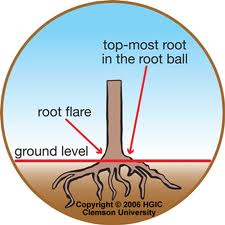
by Sheila Dunning | Jan 19, 2018
We plant trees with the intention of them being there long after we are gone. However, m any trees and shrubs fail before ever reaching maturity. Often this is due to improper installation and establishment. Research has shown that there are techniques to improve survivability. Before digging the hole:
any trees and shrubs fail before ever reaching maturity. Often this is due to improper installation and establishment. Research has shown that there are techniques to improve survivability. Before digging the hole:
- Look up. If there is a wire, security light, or building nearby that could interfere with proper development as it grows, plant elsewhere.
- Dig a shallow planting hole as wide as possible. Shallow is better than deep! Many people plant trees too deep. A hole about one-and-one-half the diameter of the width of the root ball is recommended. Wider holes should be used for compacted soil and wet sites. In most instances, the depth of the hole should be LESS than the height of the root ball, especially in compacted or wet soil. If the hole was inadvertently dug too deep, add soil and compact it firmly with your foot. .
- Find the point where the top-most root emerges from the trunk. If this is buried in the root ball then remove enough soil from the top so the point where the top-most root emerges from the trunk is at the surface. Burlap on top of the ball may have to be removed to locate the top root.
- Slide the plant carefully into the planting hole. To avoid damage when setting a large tree in the hole, lift the tree with straps or rope around the root ball, not by the trunk. Special strapping mechanisms need to be constructed to carefully lift trees out of large containers.
- Position the plant where the top-most root emerges from the trunk slightly above the landscape soil surface. It is better to plant a little high than to plant it too deep. Remove most of the soil and roots from on top of the root flare and any growing around the trunk or circling the root ball. Once the root flare is at the appropriate depth, pack soil around the root ball to stabilize it. Soil amendments are usually of no benefit. The soil removed from the hole and from on top of the root ball makes the best backfill unless the soil is terrible or contaminated. Insert a square-tipped balling shovel into the root ball tangent to the trunk to remove the entire outside periphery. This removes all circling and descending roots on the outside edge of the root ball.
- Straighten the plant in the hole. Before you begin backfilling have someone view the plant from two directions perpendicular to each other to confirm that it is straight. Break up compacted soil in a large area around the plant provides the newly emerging roots room to expand into loose soil. This will hasten root growth translating into quicker establishment Fill in with some more backfill soil to secure the plant in the upright position.
- Remove synthetic materials from around trunk and root ball. Synthetic burlap needs to be completely removed from the root ball; treated burlap can be left in place. String, strapping, plastic, and other materials that will not decompose and must be removed from the trunk at planting. Remove the wire above the soil surface from wire baskets before backfilling.
- Apply a 3-inch-layer of mulch. To retain moisture and suppress weeds cover the outer half of the root ball with an organic mulch. Do not cover the stem of the plant or the connecting root flare.
- Water consistently until established. For nursery stock less than 2-inches in caliper, this will require every other day for 2 months, followed by weekly 3-4 months. At each irrigation, apply 2 to 3 gallons of water per inch trunk caliper directly over the root ball. Never add irrigation if the ground is saturated.
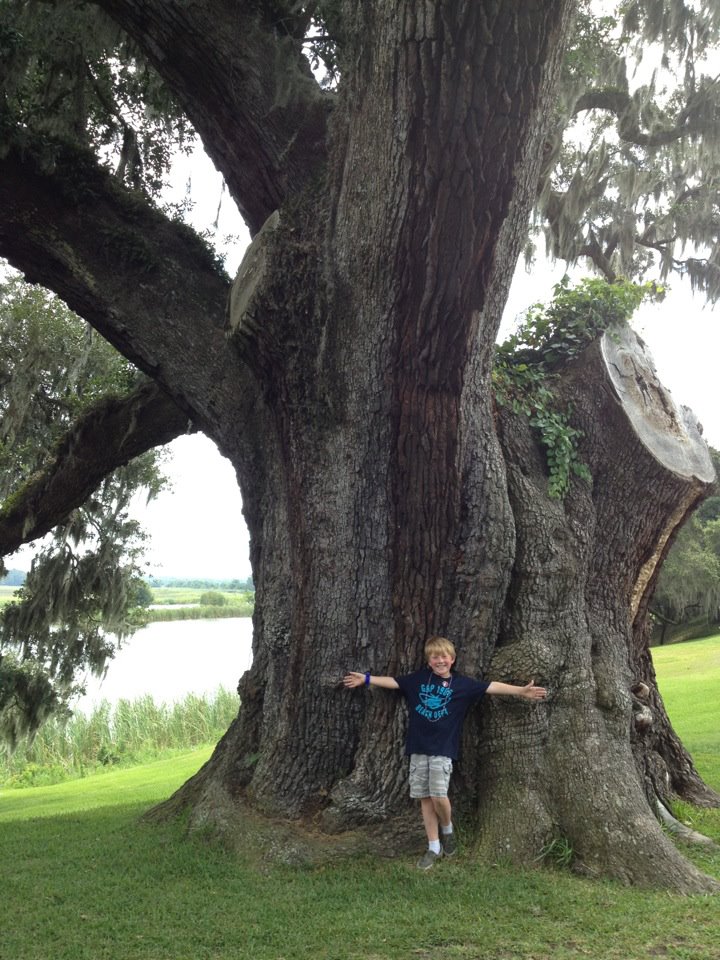
by Carrie Stevenson | Jan 5, 2018
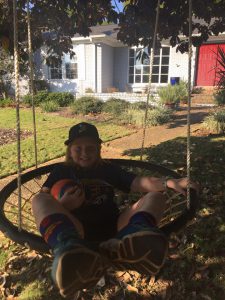
The swing hanging from our magnolia tree has provided many happy memories for our family. Photo credit: Carrie Stevenson
Do you have a favorite tree? Often, the trees in our lives tell a story.
One of the selling points when we bought our house 14 years ago was the tall, healthy Southern magnolia in the front yard. It was beautiful, and I could see it out my front window. A perfect shade tree, I could envision a swing hanging from its branches one day. Within six months of moving into the house, Hurricane Ivan struck. A neighbor’s tree fell and sheared off a quarter of the branches from our beloved magnolia. We were lucky to have minimal damage otherwise, and hoped the tree would survive.
The branches and leaves eventually filled in, and we added that swing I had imagined. One day I was pushing my daughter in the swing, when a car slowed on our street and stopped at our mailbox. A man stepped out and asked, “Are you enjoying that tree?” I responded that we very much were, and with a smile, he explained that his family built our house and that he planted that very magnolia tree 40 years before, when his son was born. He was so happy to see us enjoying the tree that he could not help but stop.
I was so grateful to hear that story and know that our family’s favorite tree held such special meaning. Our enjoyment existed because of the joyous celebration of a new birth. That is why we plant trees. For the benefit of those yet unborn, to commemorate special moments, and to provide the very oxygen we breathe. As the Greek proverb goes, “Society grows great when old men plant trees whose shade they know they shall never sit in.”
January 19 is Florida’s Arbor Day, a time to celebrate the many benefits of trees, and the day is often celebrated by planting new trees. Winter is the best time of year to plant trees, as they are able to establish roots without competing with the energy needs of new branches and leaves that come along in springtime.
“The best time to plant a tree is twenty years ago. The second best time is now.” –Anonymous
Check with your local Extension offices, garden clubs, and municipalities to find out if there is an Arbor Day event near you! Several local agencies have joined forces to organize tree giveaway events in observance of Florida’s Arbor Day.
Escambia County:
Thursday, January 18:
Deadline for UF IFAS Extension/Escambia County’s second annual Arbor Day Mail Art Contest. To participate, mail a drawing, painting, or mixed media artwork with the theme, “Strong Trees, Strong Communities” to Arbor Day Art Contest c/o Escambia County Extension, 3740 Stefani Road, Cantonment, FL 32533. Please include your name, age, and contact information on the back of your artwork. Contest entries must arrive by mail or be dropped off by Jan. 18 and will be judged at the tree giveaway on Jan. 20 at Barrineau Park Community Center.
First place winners of the art contest will receive prizes including a seven-gallon tree, a shovel, and a tree book. Second place winners will receive a tree book and third place winners will receive gardening gloves. Categories include children (12-under), teen (13-18), and adult (over 18). All participants in attendance at the tree giveaway will receive a special edition Arbor Day water bottle featuring last year’s winning design.
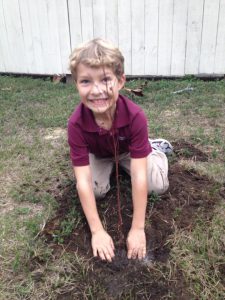
Many communities plant trees to celebrate Arbor Day. Photo credit: Carrie Stevenson
Saturday, January 20th
Escambia County will hold their tree giveaway and public planting from 10 a.m. to noon Saturday, Jan. 20 at Barrineau Park Community Center, located at 6055 Barrineau Park Road, Molino. Support for the event is provided by the Florida Forest Service, Resource Management Services, and Escambia County UF-IFAS Extension. Each attendee will receive two free native 1-gallon trees. Species available include tulip poplar, Chickasaw plum, Shumard oak, and fringetree.
For more information about either Escambia event, contact Carrie Stevenson, Coastal Sustainability Agent III, UF IFAS Extension, at 850-475-5230 or ctsteven@ufl.edu.
Santa Rosa County:
Friday, January 19
10 am—Navarre Garden Club Arbor Day celebration. Foresters will give away 1-gallon containerized trees and conduct a have tree planting demo. 7254 Navarre Parkway, Navarre, 32566. For more information, contact Mary Salinas, 850-623-3868 or maryd@santarosa.fl.gov
Saturday, January 20th
10 am—Milton Garden Club Arbor Day celebration. Foresters will give away 1-gallon containerized trees and conduct a have tree planting demo. 5256 Alabama Street, Milton. For more information, contact Mary Salinas, 850-623-3868 or maryd@santarosa.fl.gov
Leon County:
Saturday, January 20th
9am to 12pm – City of Tallahassee/Leon County Arbor Day Celebration – Join City and County Staff, UF/IFAS Leon County Extension Faculty and Master Gardener volunteers at the Apalachee Regional Park (7550 Apalachee Pkwy) for a tree planting in honor of Arbor Day. Citizens are invited to come help plant hundreds of trees in the park and also learn about the benefits of trees, how to properly plant a tree, and after the planting is done, take a tree identification walk. For more information, contact Mindy Mohrman, City/County Urban Forester at 850.891.6415 or melinda.mohrman@talgov.com

by Carrie Stevenson | Nov 3, 2017
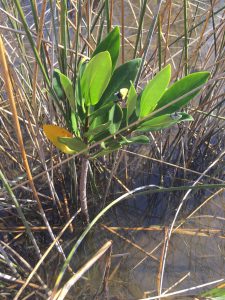
Red mangrove growing among black needlerush in Perdido Key. Photo credit: Carrie Stevenson, UF IFAS Extension
Discovering something new is possibly the most exciting thing a field biologist can do. As students, budding biologists imagine coming across something no one else has ever noticed before, maybe even getting the opportunity to name a new bird, fish, or plant after themselves.
Well, here in Pensacola, we are discovering something that, while already named and common in other places, is extraordinarily rare for us. What we have found are red mangroves. Mangroves are small to medium-sized trees that grow in brackish coastal marshes. There are three common kinds of mangroves, black (Avicennia germinans), white (Laguncularia racemosa), and red (Rhizophora mangle).
Black mangroves are typically the northernmost dwelling species, as they can tolerate occasional freezes. They have maintained a large population in south Louisiana’s Chandeleur Islands for many years. White and red mangroves, however, typically thrive in climates that are warmer year-round—think of a latitude near Cedar Key and south. The unique prop roots of a red mangrove (often called a “walking tree”) jut out of the water, forming a thick mat of difficult-to-walk-through habitat for coastal fish, birds, and mammals. In tropical and semi-tropical locations, they form a highly productive ecosystem for estuarine fish and invertebrates, including sea urchins, oysters, mangrove and mud crabs, snapper, snook, and shrimp.
Interestingly, botanists and ecologists have been observing an expansion in range for all mangroves in the past few years. A study published 3 years ago (Cavanaugh, 2014) documented mangroves moving north along a stretch of coastline near St. Augustine. There, the mangrove population doubled between 1984-2011. The working theory behind this expansion (observed worldwide) is not necessarily warming average temperatures, but fewer hard freezes in the winter. The handful of red mangroves we have identified in the Perdido Key area have been living among the needlerush and cordgrass-dominated salt marsh quite happily for at least a full year.
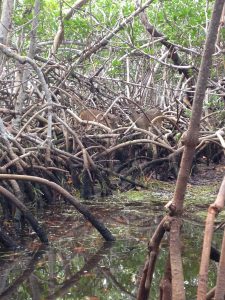
Key deer thrive in mangrove forests in south Florida. Photo credit: Carrie Stevenson, UF IFAS Extension
Two researchers from Dauphin Island Sea Lab are planning to expand a study published in 2014 to determine the extent of mangrove expansion in the northern Gulf Coast. After observing black mangroves growing on barrier islands in Mississippi and Alabama, we are working with them to start a citizen science initiative that may help locate more mangroves in the Florida panhandle.
So what does all of this mean? Are mangroves taking over our salt marshes? Where did they come from? Are they going to outcompete our salt marshes by shading them out, as they have elsewhere? Will this change the food web within the marshes? Will we start getting roseate spoonbills and frigate birds nesting in north Florida? Is this a fluke due to a single warm winter, and they will die off when we get a freeze below 25° F in January? These are the questions we, and our fellow ecologists, will be asking and researching. What we do know is that red mangrove propagules (seed pods) have been floating up to north Florida for many years, but never had the right conditions to take root and thrive. Mangroves are native, beneficial plants that stabilize and protect coastlines from storms and erosion and provide valuable food and habitat for wildlife. Only time will tell if they will become commonplace in our area.
If you are curious about mangroves or interested in volunteering as an observer for the upcoming study, please contact me at ctsteven@ufl.edu. We enjoy hearing from our readers.

 As the trees begin to turn various shades of red, many people begin to inquire about the Popcorn trees. While their autumn coloration is one of the reasons they were introduced to the Florida environment, it took years for us to realize what a menace Popcorn trees have become. Triadica sebifera, the Chinese tallowtree or Popcorn tree, was introduced to Charleston, South Carolina in the late 1700s for oil production and use in making candles, earning it another common name, the Candleberry tree. Since then, it has spread to every coastal state from North Carolina to Texas, and inland to Arkansas. In Florida it occurs as far south as Tampa. It is most likely to spread to wildlands adjacent to or downstream from areas landscaped with Triadica sebifera, displacing other native plant species in those habitats. Therefore, Chinese tallowtree was listed as a noxious weed by the Florida Department of Agriculture and Consumer Services Noxious Weed List (5b-57.007 FAC) in 1998, which means that possession with the intent to sell, transport, or plant is illegal in the state of Florida. The common name of Florida Aspen is sometimes used to market Popcorn tree in mail-order ads. Remember it’s still the same plant.
As the trees begin to turn various shades of red, many people begin to inquire about the Popcorn trees. While their autumn coloration is one of the reasons they were introduced to the Florida environment, it took years for us to realize what a menace Popcorn trees have become. Triadica sebifera, the Chinese tallowtree or Popcorn tree, was introduced to Charleston, South Carolina in the late 1700s for oil production and use in making candles, earning it another common name, the Candleberry tree. Since then, it has spread to every coastal state from North Carolina to Texas, and inland to Arkansas. In Florida it occurs as far south as Tampa. It is most likely to spread to wildlands adjacent to or downstream from areas landscaped with Triadica sebifera, displacing other native plant species in those habitats. Therefore, Chinese tallowtree was listed as a noxious weed by the Florida Department of Agriculture and Consumer Services Noxious Weed List (5b-57.007 FAC) in 1998, which means that possession with the intent to sell, transport, or plant is illegal in the state of Florida. The common name of Florida Aspen is sometimes used to market Popcorn tree in mail-order ads. Remember it’s still the same plant.











